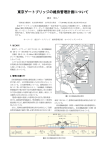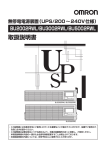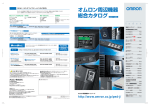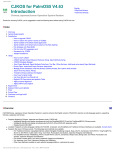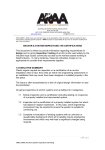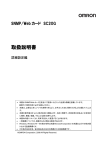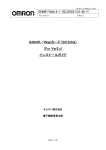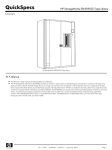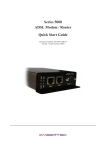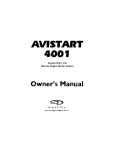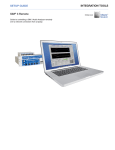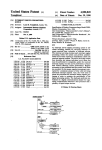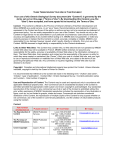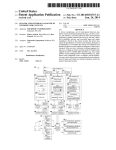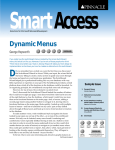Download | ENTERTEXTMODE I~s\300
Transcript
US 20060293 890Al (19) United States (12) Patent Application Publication (10) Pub. No.: US 2006/0293890 A1 (43) Pub. Date: Blair et al. (54) SPEECH RECOGNITION ASSISTED AUTOCOMPLETION OF COMPOSITE CHARACTERS Dec. 28, 2006 Publication Classi?cation (75) Inventors: Colin Blair, Westleigh (AU); Kevin (51) Int. Cl. G10L 15/26 (52) us. c1. ............................................................ ..704/235 (2006.01) Chan, Ryde (AU); Christopher R. (57) Gentle, Gladesville (AU); Neil HepWorth, Artarmon (AU); Andrew Speech recognition assisted autocompletion of textual com W. Lang, Epping (AU) Correspondence Address: posite Words or characters (i.e. Words or characters contain ing a number of components) is provided. In response to SHERIDAN ROSS RC. user input specifying a component of a Word or character, a list of candidate Words or characters is generated. The 1560 BROADWAY, SUITE 1200 desired Word or character can be selected, or the list of candidate Words or characters can be narrowed, in response to the user speaking the desired Word or character. As a result, entry of Words or characters formed from a number DENVER, CO 80202 (US) (73) Assignee: Avaya Technology Corp., Basking Ridge, NJ (US) (21) Appl. No.: (22) ABSTRACT Filed: of letters, strokes, or Word shapes is facilitated by user input comprising a combination of a speci?cation of a component 11/170,302 of the desired Word or character and speech corresponding Jun. 28, 2005 to a pronunciation of the desired Word or character. | ENTERTEXTMODE I~s\300 RECEIVE U SER INPUT SELECTING COMPONENT OF WORD 0R CHARACTER? YES 304 CREATE LIST OF CANDIDATE WORDS OR CHARACTERS \‘\ 308 DISPLAY AT LEAST A PORTION OF THE CANDIDATE LIST TO USER N0 SPEECH INPUT FROM USER RECEIVED AND RECOGNIZED AS REPRESENTING OR BEING ASSOCIATE ITH CANDIDATE WORD(S) OR CHARACTER (5)? YES I CREATE REVISED LIST OF CANDIDATE WORD S) OR CHARACTER( ) DISPLAY AT LEAST A PORTION OF THE REVISED LIST TO THE USER USER SELECTION OF LISTED WORD OR CHARACTER RECEIVED? YES END 332 Patent Application Publication Dec. 28, 2006 Sheet 1 0f 4 120 100 124 / US 2006/0293890 A1 / A PROCESSOR DATA STORAGE 128 \-r~ F104 SPEECH RECOGNITION ' APPLICATION 132 \I“ CHARACTER SELECTION A V MEMORY A V USER INPUT E _ USER ‘ ' OUTPUT 108 V APPLICATION TABLE OF CANDIDATE CHARACTERS r112 V COMMUNICATION 136‘ NETWORK INTERFACE = E v “116 Patent Application Publication Dec. 28, 2006 Sheet 2 0f 4 US 2006/0293890 A1 220 / Ci ,v 100,200 // /*"\--~ 1 6,216 / 208 SEND ‘ E] /223" ] iii *IQ 2 ABC} 3 DEF a 1:‘: m] "w 5E E1 5 11$ 4 GH! 0 MNOJ 1 5 JKL ‘ .224 > 204 arm 224 -_-/ TPQRS * g ] 9<2B a TUV D :férn swxvzi J . \ 214 k # J \ J 112 Patent Application Publication Dec. 28, 2006 Sheet 3 0f 4 ENTER TEXT MODE II II RECEIVE USER INPUT SELECTING COMPONENT OF WORD OR CHARACTER? YES II CREATE LIST OF CANDIDATE WORDS OR CHARACTERS II DISPLAY AT LEAST A PORTION OF THE CANDIDATE LIST TO USER V No II SPEECH INPUT FROM USER RE CEIVED AND RECOGNIZED AS REPRESENTING OR BEING ASSOCIATED WITH CANDIDATE WORD(S) OR CHARACTER(S)? YES II CREATE REVISED LIST OF CANDIDATE WORDéS) OR CHARACTER( ) II DISPLAY AT LEAST A PORTION OF THE REVISED LIST TO THE USER V V USER SELECTION OF LISTED WORD OR CHARACTER RECEIVED? YES @ FIG.3 US 2006/0293890 A1 Patent Application Publication Dec. 28, 2006 Sheet 4 0f 4 US 2006/0293890 A1 /216 CHINESE TEXT ) -___ FIG.4A MENU EXIT 40 216 CHINESE TEXT / 408d 406a J FIG.4B MENU EXIT _/ CHINESE TEXT 216 FIG.4C ' EXIT 408C /H CHINESE TEXT MENU EXIT J 216 FIG.4D US 2006/0293890 A1 SPEECH RECOGNITION ASSISTED AUTOCOMPLETION OF COMPOSITE CHARACTERS FIELD OF THE INVENTION [0001] The present invention is directed to the entry of composite characters. In particular, the present invention facilitates the entry of Words or characters into communi cations or computing devices by combining manual user input and speech recognition to narroWly tailor lists of candidate Words or characters. BACKGROUND Dec. 28, 2006 SUMMARY [0006] The present invention is directed to solving these and other problems and disadvantages of the prior art. In accordance With embodiments of the present invention, speech recognition is used to ?lter or narroW a list of candidate composite characters, such as Words (for example in connection With English language text) or characters (for example in connection With Chinese text). In particular, folloWing a user’s manual input of a letter, stroke or Word shape of the Word or character being entered, the user may speak that character. Speech recognition softWare then attempts to eliminate Words or characters from the candidate list that sound different from the spoken Word or character. Accordingly, even a relatively rudimentary speech recogni bene?t from the entry of text. For example, text messaging tion application can be effective in at least eliminating some Words or characters from the candidate list. Furthermore, by ?rst providing a letter, stroke or other component of a Word or character through a selection or input of that component, services used in connection With cellular telephones are noW the range of available or candidate Words or characters is in Widespread use. As a further example, portable devices are increasingly used in connection With email applications. HoWever, the space available on portable devices for key boards is extremely limited. Therefore, the entry of text into such devices can be dif?cult. In addition, the symbols used by certain languages can be di?icult to input, even in connection With larger desktop communication or comput more narroWly de?ned, Which can reduce the accuracy [0002] Mobile communication and computing devices that are capable of performing a Wide variety of functions are noW available. Increasingly, such functions require or can ing devices. [0003] In order to facilitate the entry of Words or charac ters, particularly using the limited keypad of a portable required of the speech recognition application in order to further narroW that range (i.e., narroW the candidate list) or positively identify the Word or character that the user seeks to enter. BRIEF DESCRIPTION OF THE DRAWINGS [0007] FIG. 1 is a block diagram of components of a communication or computing device in accordance With embodiments of the present invention; telephone or other device, autocompletion features are avail [0008] able. Such features can display a list of candidate Words or characters to the user in response to receiving an initial set dance With embodiments of the present invention; FIG. 2 depicts a communication device in accor of inputs from a user. These inputs may include speci?cation [0009] of the ?rst feW letters of a Word, or the ?rst feW strokes of a character, such as a Chinese character. HoWever, because operation of a speech recognition assisted autocompletion the resulting list can be extremely long, it can be di?icult for a user to quickly locate the desired Word or character. [0004] In order to address the problem of having a long list of auto complete candidates, systems are available that FIG. 3 is a ?owchart depicting aspects of the process in accordance With embodiments of the present invention; and [0010] FIGS. 4A-4D depict example display outputs in accordance With embodiments of the present invention. DETAILED DESCRIPTION provide a list in Which the candidate Words or characters are ranked according to their frequency of use. Ranking the [0011] candidates according to their frequency of use can reduce the need for the user to scroll through the entire list of candidates. HoWever, it can be dif?cult to order a list of invention, a Word or character may be included in a list of Words or characters (collectively referred to herein as “char acters”) available for selection by a user in response to user candidate Words or characters in a sensible fashion. In addition, Where the user is seeking an unusual Word or character, such as a letter (for example in the case of an character, little or no time-savings may be realiZed. English Word) or a stroke or Word shape (for example in the [0005] As an alternative to requiring manual input from a user, voice or speech recognition systems are available for entering text or triggering commands. HoWever, the accu racy of such systems often leaves much to be desired, even after user training and calibration. Furthermore, a full featured voice recognition system often requires processing and memory resources that are not typically found on mobile communication or computing devices, such as cellular tele phones. As a result, speech recognition functions available in connection With mobile devices are often rudimentary, and usually geared toWards recogniZing a narroW subset of the spoken Words in a language. Furthermore, speech rec ognition on mobile devices is often limited to triggering menu commands, such as accessing an address book and dialing a selected number. In accordance With embodiments of the present input indicating that a particular component of a Word or case of a Chinese character), is included in the desired character. In addition, the list of characters can be narroWed in response to speech input from the user. In particular, in response to the receipt of speech input from the user that can be used to identify characters in the candidate list that are associated (or not) With the received speech, the content of the candidate list is altered. Accordingly, entry of characters is facilitated by providing a shorter list of candidate Words or characters, or by the identi?cation of an exact character, through the combined use of a component of the desired character input by a user, and speech recognition that receives as input the user’s pronunciation of the desired character. [0012] With reference noW to FIG. 1, components of a communications or computing device 100 in accordance US 2006/0293890 A1 Dec. 28, 2006 With embodiments of the present invention are depicted in block diagram form. The components may include a pro cessor 104 capable of executing program instructions. data storage 120. Furthermore, according to embodiments of the present invention, a speech recognition application 128 Accordingly, the processor 104 may include any general purpose programmable processor or controller for executing cooperation With communication application softWare, Word application programming. Alternatively, the processor 104 may comprise a specially con?gured application speci?c integrated circuit (ASIC). The processor 104 generally func tions to run programming code implementing various func tions performed by the communication or computing device 100, including Word or character selection operations as described herein. [0013] A communication or computing device 100 may additionally include memory 108 for use in connection With the execution of programming by the processor 104 and for the temporary or long term storage of data or program instructions. The memory 108 may comprise solid state memory resident, removable or remote in nature, such as DRAM and SDRAM. Where the processor 104 comprises a controller, the memory 108 may be integral to the processor 104. [0014] and/or character selection application 132 may operate in processing softWare or other applications that can receive Words or characters entered or selected by a user as input. [0017] A communication or computing device 100 may also include one or more communication netWork interfaces 136. Examples of communication netWork interfaces include cellular telephony transceivers, a netWork interface card, a modem, a Wireline telephony port, a serial or parallel data port, or other Wireline or Wireless communication netWork interface. [0018] With reference noW to FIG. 2, a communication or computing device 100 comprising a cellular telephone 200 is depicted. The cellular telephone 200 generally includes a user input 112 comprising a numeric keypad 204, cursor control button 208, enter button 212, and microphone 214. In addition, the cellular telephone 200 includes user outputs comprising a visual display 216, such as a color or mono chrome liquid crystal display (LCD), and speaker 220. In addition, the communication or computing device 100 may include one or more user inputs 112 and one or more user outputs 116. Examples of user inputs 112 include keyboards, keypads, touch screen inputs, and micro phones. Examples of user outputs 116 include speakers, display screens (including touch screen displays) and indi cator lights. Furthermore, it can be appreciated by one of skill in the art that the user input 112 may be combined or operated in conjunction With a user output 116. An example of such an integrated user input 112 and user output 116 is a touch screen display that can both present visual informa tion to a user and receive input selections from a user. [0015] A communication or computing device 100 may also include data storage 120 for the storage of application [0019] When in a text entry or selection mode, a user can, in accordance embodiments With the present invention, cause a partial or complete list containing one or more Words or characters to be displayed in the display screen 216, in response to input comprising speci?ed letters, strokes or Word shapes entered by the user through the keypad 204. As can be appreciated by one of skill in the art, each key included in the keypad may be associated With a number of letters or character shapes, as Well as With other symbols. For instance, the keypad 204 in the example of FIG. 2 associates three (and sometimes 4) letters 224 With keys 2-9. In addition, the keypad 204 in the example of FIG. 2 associates three (and in one case four) Chinese root radical softWare 124 may be stored in the data storage 120. The data categories 228 With keys 2-9. As can be appreciated by one of skill in the art, such root radicals may be selected in connection With specifying the shapes comprising a com storage 120 may comprise, for example, a magnetic storage plete Chinese character, for example using the WubiZixing programming and/or data. In addition, operating system shape based method for continuing Chinese characters. In device, a solid state storage device, an optical storage device, a logic circuit, or any combination of such devices. It should further be appreciated that the programs and data that may be maintained in the data storage 120 can comprise softWare, ?rmware or hardWare logic, depending on the may select a letter or Word shape associated With a particular particular implementation of the data storage 120. key included in the keypad 204 by pressing or tapping the [0016] Examples of applications that may be stored in the data storage 120 include the speech recognition application 128 and Word or character selection application 132. In addition, the data storage 120 may contain a table or database of candidate Words or characters 134. As described addition, selection of one of the root radicals can make available related radicals to alloW the user to specify a desired Word shape With particularity. Accordingly, a user key associated With a desired letter or Word shape multiple times. [0020] The list of candidate characters created as a result of the selection of letters or Word shapes is displayed, at least herein, a speech recognition application 128, character in part, by the visual display 216. If the list is long enough that it cannot all be conveniently presented in the display selection application 132 and/or table of candidate Words or characters 134 may be integrated With one another, and/or operate in cooperation With one another. The data storage used to scroll through the complete list. The cursor button 208 or other input 112 may also be used in connection With 216, the cursor button 208 or some other input 112 may be 120 may also contain application programming and data used in connection With the performance of other functions of the communication or computing device 100. For example, in connection With a communication or computing the selection of a desired character, for example by high lighting the desired character in a displayed list using the device 100 such as a cellular telephone, the data storage may include communication application softWare. As another addition, as described herein, the list of candidate characters can be narroWed based on speech provided by the user to the example, a communication or computing device 100 such as device 100 through the microphone 214 that is then pro a personal digital assistant (PDA) or a general purpose computer may include a Word processing application and cessed by the device 100, for example, through the speech recognition application 128. Furthermore, the speech recog cursor button 208 or other input 112, and then selecting that character by, for example, pressing the enter button 212. In US 2006/0293890 A1 Dec. 28, 2006 nition application 128 functions in cooperation With the character selection application 132 such that the speech recognition application 128 tries to identify characters included in a list generated by the character selection reduced. At least a portion of the revised list is then displayed to the user (step 328). Should the revised list contain too many candidates to be displayed by a user output application 132 in response to manual or other user input user may again scroll through that list. specifying a component of the desired character, rather than trying to identify all Words that may be included in the speech recognition application 128 vocabulary. [0021] With reference noW to FIG. 3, aspects of the operation of a communications or computing device 100 providing speech recognition assisted autocompletion of characters, such as English language Words or Chinese language characters in accordance With embodiments of the present invention are illustrated. Initially, at step 300, the 116, such as a liquid crystal display 216, simultaneously, the [0023] At step 332, a determination may again be made as to Whether the user has selected one of the candidate characters. This determination may be made either after it is determined that the user has not provided speech in order to produce the list of candidate characters, or after creating a revised list of candidate list of characters at step 328. If the user has selected a listed character, the process ends. The user may then exit the text mode or begin the process of selecting a next character. user enters or selects a text entry mode. For example, Where the device 100 comprises a cellular telephone 200, a text entry mode may comprise starting a text messaging appli cation or mode. At step 304, a determination is made as to Whether user input is received in the form of a manual selection of a component (e.g., a letter, stroke, or Word shape) of a Word or character. In general, embodiments of the present invention operate in connection With receipt of such input from the user to create the initial list of candidate characters. After receiving selection of a component of a character, a list of candidate characters containing the selected component is created (step 308). At least a portion of the candidate list is then displayed to the user (step 312). As can be appreciated by one of skill in the art, the list of candidate characters can be quite long, particularly When only a single component is speci?ed. Accordingly, the display, such as the liquid crystal display 216 of a cellular telephone 200, may be able to display only a small portion of the candidate list. Where only a portion of the candidate [0024] If the user has not yet selected a listed character, the process may return to step 304, at Which point the user may enter an additional component, such as an additional letter, stroke or Word shape. The list of characters that may then be created at step 308 comprises a revised list of characters to re?ect the additional component that has noW been speci?ed by the user. For instance, Where a user has speci?ed tWo letters or Word shapes, those letters or Word shapes may be required in each of the candidate characters. The resulting list may then be displayed, at least in part (step 312). After displaying the revised list to the user at step 312, the user may make another attempt at providing speech input in order to further reduce the number of candidate characters in the list (step 320). Alternatively, if a selection of a listed character is not made by the user at step 332, the user may decide not to provide additional input in the form of an additional component of the desired composite character at step 312 and may instead proceed to step 320, to make list can be displayed at any one time, the user may scroll another attempt at narroWing the list of candidates by through that list to search for the desired character. providing speech input. If additional speech input is pro [0022] vided, that input may be used to create a revised list of candidate characters (step 324) and that revised list can be The user may then choose to narroW the candidate list by providing speech input. Accordingly, a determination displayed at least in part, to the user (step 328). Accordingly, it can be appreciated that multiple iterations of specifying may then be made as to Whether speech input from the user is received and recogniZed as representing or being associ ated With a pronunciation of a candidate character (step components of a Word or character and/or providing speech 320). In particular, speech received, for example through a to identify a desired Word or character or to at least reduce microphone 214, is analyZed by the speech recognition application 128, to determine Whether a match With a candidate character can be made. If a match can be made, a revised list of candidate characters is created (step 324). As can be appreciated by one of skill in the art, even a rudimentary speech recognition application 128 may be capable of positively identifying a single character from the list, particularly When the list has been bounded through the receipt of one or more components that are included in the character that the user Wishes to enter. As can also be appreciated by one of skill in the art, a speech recognition application 128 may be able to reduce the siZe of a list of candidate characters, even if a particular character cannot be identi?ed from that list. For example, Where the speech recognition application 128 is able to associate speech input by the user With a subset of the list of candidate characters, the revised list may comprise that subset of characters. Accordingly, a speech recognition application 128 may serve to eliminate from a list of candidates those Words or characters that have a spoken sound that is different from the spoken sound of the desired Word or character. Accordingly, the number of candidates that a user must (at least at this point) search in order to ?nd a desired Word or character is the siZe of the list of candidates, can be performed. [0025] With reference noW to FIGS. 4A-4C, examples of the visual output that may be provided to a user in connec tion With operation of embodiments of the present invention are depicted. In particular, the display screen 216 of a device 100 comprising a cellular telephone 200 in a Chinese language text entry mode is depicted. As shoWn in FIG. 4A, the user may select one or more strokes 404 of a desired character. The selection of strokes 404 may be performed by pressing those keys included in the keyboard 204 that are associated With the ?rst strokes forming the character that the user desires to specify. [0026] Because Chinese characters are formed from eight basic strokes, and because there are many thousands of Chinese characters in use, specifying tWo strokes of a desired character Will typically result in the generation of a long list of candidate characters. A partial list 40611 of candidate characters 408a-d that begin With the strokes 404 speci?ed in the present example is illustrated in FIG. 4B. The ?rst character 40811 is pronounced roughly as “nin,” the second character 40819 is pronounced roughly as “Wo,” the third character is pronounced roughly as “ngo,” and the US 2006/0293890 A1 fourth character is pronounced roughly as “sanng.” From this list, the user may desire the third character 4080. In accordance With embodiments of the present invention, the user may make a selection from the candidate list by voicing the desired character. Accordingly, the user may pronounce the third character 408c, causing the list to be modi?ed so as to contain only that character 4080, as shoWn in FIG. 4C. The user can then con?rm that the speech recognition application 128 running on or in association With the cellular telephone 200 has correctly narroWed the list to that char acter by hitting the enter key 212, or otherWise entering a selection of that character. Therefore, it can be appreciated that in accordance With embodiments of the present inven tion the manual entry of components of a character and speech recognition Work in combination to facilitate the selection by a user of a character comprised of a large number of strokes. Furthermore, this can be accomplished simply by entering at least one of those strokes and by then voicing the desired character. This combination is advanta geous in that even if the speech recognition application 128 is not accurate enough to discern the desired character solely from the spoken sound of that character, it Will likely be able to distinguish the vastly different sounds of similar looking characters. Dec. 28, 2006 [0029] The foregoing discussion of the invention has been presented for purposes of illustration and description. Fur ther, the description is not intended to limit the invention to the form disclosed herein. Consequently, variations and modi?cations commensurate With the above teachings, Within the skill or knoWledge of the relevant art, are Within the scope of the present invention. The embodiments described hereinabove are further intended to explain the best mode presently knoWn of practicing the invention and to enable others skilled in the art to utiliZe the invention in such or in other embodiments and With the various modi? cations required by their particular application or use of the invention. It is intended that the appended claims be con strued to include alternative embodiments to the extent permitted by the prior art. What is claimed is: 1. A method for specifying a Written character, compris ing: receiving a selection of at least a ?rst character compo nent; generating a ?rst list of candidate characters containing said ?rst selected component; [0027] Furthermore, even if the speech recognition soft receiving ?rst speech input from a user; and Ware 128 is unable to discern the desired character from the using said ?rst speech input from a user to modify said ?rst list of candidate characters, Wherein a second list of candidate characters is generated. spoken sound With reference to the list of candidate char acters generated in response to one or more manually entered strokes, it should be able to narrow the list of candidate characters. For example, the speech recognition softWare 128 may not be able to discern betWeen the second 408!) (“W0”) and third 408c (“ngo”) characters based on the user’s speech input While the list of candidate characters shoWn in FIG. 4B is active. HoWever, that speech input should alloW the speech recognition softWare 128 to elimi nate the ?rst 408a (“nin”) and fourth 408d (“sanng”) char acters as candidates. Accordingly, through the combination of manual input and speech recognition of embodiments of the present invention, the list of candidates may be narroWed to the second 408!) and third 4080 characters, shoWn in FIG. 4D as list 4061). The user may then select the desired character from the narroWed list 4061) by, for example, highlighting that character using the cursor control button 208 and pressing the enter key 212. [0028] Although certain examples of embodiments of the present invention described herein have discussed using manual entry through keys in a keypad of one or more components of a desired Word or character, and/or the selection of a desired Word or character, embodiments of the present invention are not so limited. For example, manual 2. The method of claim 1, Wherein said ?rst speech input comprises speech corresponding to a pronunciation of a desired character. 3. The method of claim 2, Wherein said desired character is included in said ?rst list, and Wherein said second list contains only said desired character. 4. The method of claim 2, Wherein said modi?cation to said ?rst list comprises removing characters that do not correspond to said pronunciation of said desired character. 5. The method of claim 4, Wherein said second list contains a number of candidate characters. 6. The method of claim 1, further comprising: receiving a second speech input from a user, Wherein said second list is modi?ed, Wherein a third list of candidate characters is generated. 7. The method of claim 1, further comprising: receiving a selection of a second character component; using said second selected component to modify said second list of candidate characters, Wherein a third list entry may be performed by making selections from a touch of candidate characters is generated. 8. The method of claim 1, further comprising: screen display, or by Writing a desired component in a Writing area of a touch screen display. As a further example, receiving a selection of one of said characters from said second list. the initial (or later) selection of a component or components of a Word or character need not be performed through manual entry. For instance, a user may voice the name of the desired component to generate a list of Words or characters that can then be narroWed by voicing the desired Word or character. In addition, embodiments of the present invention have application in connection With the selection and/or entry of text in any language Where the “alphabet” or component parts of Words or symbols is beyond What can be 9. The method of claim 1, Wherein said ?rst character component comprises one of a ?rst letter of an English language Word and a ?rst stroke of a Chinese language character. 10. The method of claim 9, further comprising: receiving a selection of a second stroke of a Chinese easily represented on a normal communication or computing language character, Wherein said generating a ?rst list comprises generating a ?rst list of Chinese language characters containing said selected ?rst and second device keyboard. strokes. US 2006/0293890 A1 11. A device for facilitating selection of textual characters, comprising: a user input, Wherein a number of components of a desired character are available for selection, and Wherein a pronunciation by a user of said desired character is received; a memory, Wherein said memory contains a table of characters; and Dec. 28, 2006 and b) maintaining characters in said ?rst list that are determined to correspond to said desired character. 16. The device of claim 11, further comprising: a user output, Wherein at least a portion of said ?rst list of candidate characters is provided to a user, and Wherein at least a portion of said second list of candidate characters is provided to said user. 17. A device for selecting a character, comprising: means for receiving input from a user; a processor, Wherein in response to user input comprising at least a ?rst component of a desired character said processor executes instructions to perform a look up in said table in said memory and to form a ?rst list of candidate characters, and Wherein in response to user input comprising a pronunciation of a desired character said processor executes instructions to modify said ?rst list of candidate characters to form a second list of candidate characters containing characters determined to correspond to said pronunciation of a desired char acter 12. The device of claim 11, Wherein said second list contains a single candidate character. 13. The device of claim 11, Wherein said user input includes: a ?rst user input comprising a keypad; and a second user input comprising a microphone. 14. The device of claim 11, Wherein said user input comprises a microphone. 15. The device of claim 11, Wherein in response to receipt of said pronunciation of said desired character said proces sor executes instructions comprising a speech recognition application, and Wherein said modifying said ?rst list of candidate characters includes at least one of: a) removing characters from said ?rst list that are determined to not correspond to said pronunciation of said desired character, means for storing associations of a plurality of characters With one or more character components; means for storing an association betWeen a character and a pronunciation of said character for a number of characters included in said plurality of characters; means for generating a ?rst list of candidate characters selected from said plurality of characters in response to user input comprising at least a ?rst character compo nent; means for modifying said ?rst list of candidate characters to form a second list of candidate characters in response to user input comprising a pronunciation of a desired character. 18. The device of claim 17, Wherein said means for receiving input from a user includes means for receiving manual input from a user. 19. The device of claim 17, Wherein said means for receiving input from a user includes means for receiving speech input from a user. 20. The device of claim 17, further comprising: means for providing visual output to a user, Wherein at least a portion of said ?rst list of candidate characters is displayed.










